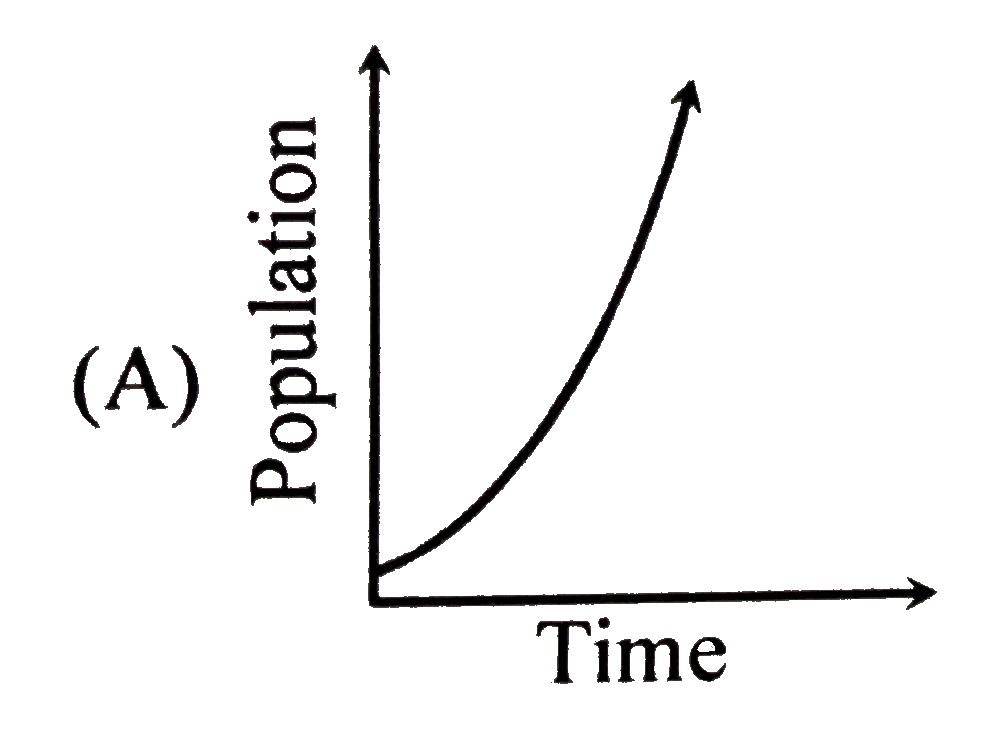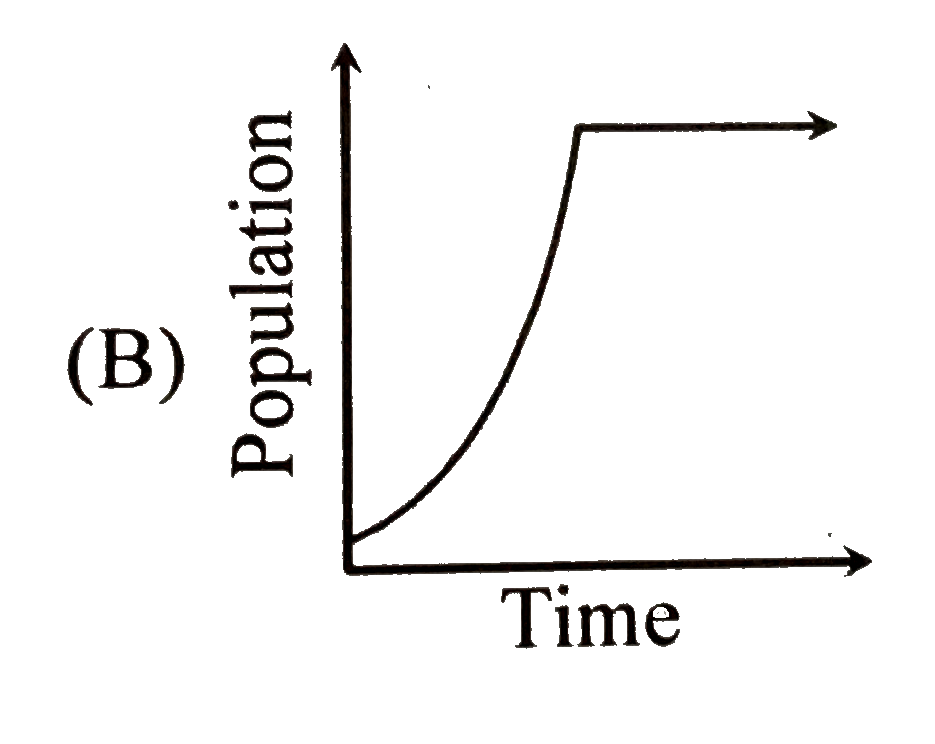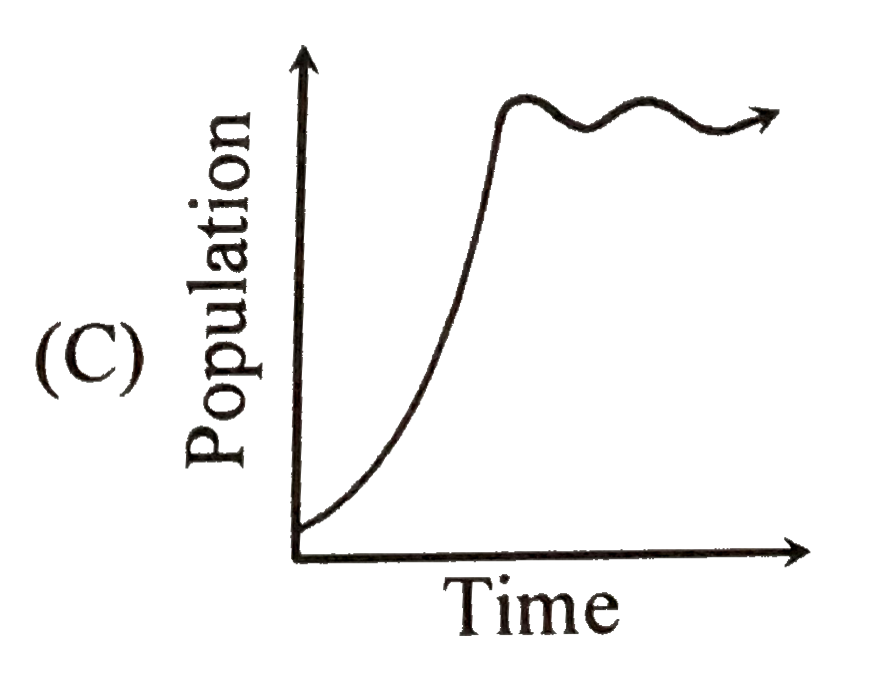A few rabbits are introduced in an un- inhabited island with plenty of food , If these rabbits breed in the absence of any disease , natural calamity and predating, which one of the following graphs best represents their population growth ?




The correct Answer is:A
Step by step video, text & image solution for A few rabbits are introduced in an un- inhabited island with plenty of food , If these rabbits breed in the absence of any disease , natural calamity and predating, which one of the following graphs best represents their population growth ? by Biology experts to help you in doubts & scoring excellent marks in Class 12 exams.
Updated on:21/07/2023Similar Questions
Study the graph given below and answer the questions that follow:

i) Write the status of food and space in the curves a) and b).
ii) In the absence of predators, which one of the two curves would appropriately depict the prey population?
iii) Time has been shown on X-axis and there is a parallel dotted line above it. Give the significance of this dotted line.
View SolutionResearchers recently announced the earth could actually withstand up to 200,000 times the current population . They arrived at this figure by calculating the amount of heat a human body emits , and only at 1.3 million billion would the earth be too hot to be habitable. And though it would feel like being in a can of sardines if that figure were ever reached ,the earth is capable of comfortably sustaining a population several times the current 6.5 billion. In fact , fertility is actually on the decline worldwide. Though population has grown ,the rate of growth has fallen sharply . Twenty years ago, the UN projected that population would reach 11.16 billion in 2050 , today they say it will reach only 9.37 billion . moreover ,human population will stabilize at about 11.5 billion . Which this figure is almost twice the current one ,it is hardly claustrophobic. True ,the demnds on resources are heavy even now, but this is more due to the manner in which these resources are being used. In fact , figures show that a bigger population does used . In fact , figures show that a bigger population does not amount to greater consumption. Over 20%1ofworld'speop≤∈thehighest∈comecountriesaountfor86%of→talprivatecon∑ptionexpenditure−thep∞rest20%at∈y1.3%Withjust5%oftheworld'spopa––tion,theUScon∑esabout40%oftheworld'spopa––tion,theUScon∑esabout40% of the world's resources , Would you say the US is overpopulated ? Concerns on scarcity of food are equally beseless . In fact , global food production has actually kept up with population growth.
Rewrite the following sentences in the ways instructed :
(i) The earth would be too hot to be habitable (Remove too.)
(ii) Thought population has grown , the rate of growth has fallen sharply. (Rewrite it using but )
(iii) Moreover ,human population will stabilize at about 11.5 billion. (Make it less definite'.)
View Solution
Knowledge Check
Read the following passage carefully and answer the questions given below it. Certain words/phrases are printed in bold to help you to locate them while answering some of the questions.
There is no field of human endeavour that has been so misunderstand as health. While health which connotes wellbeing and the absence of illness has a low profile, it is illness representing the failure of health which virtually monopolizes attention because of the fear of pain, disability and death. Even Sushruta has warned that this provides the medical practitioner power over the patient which could be misused.Till recently, patients had implicit faith in their physician whom they loved and respected, not only for his knowledge but also in the total belief that practitioners of this noble profession, guided by ethics, always placed the patient's interest above all other considerations. This rich interpersonal relationship between the physician, patient and family has, barring a few exceptions, prevailed till the recent past, for caring was considered as important as curing. Our indigenous systems of medicine like ayurveda and yoga have been more concerned with the promotion of the health of both the body and mind and with maintaining a harmonious relationship not just with fellow beings but with nature itself, of which man is an integral part. Healthy practices like cleanliness, proper diet, exercise and meditation are part of our culture which sustains people even in the prevailing conditions of poverty in rural India and in the unhygienic urban slums.These systems consider disease as an aberration resulting from disturbance of the equilibrium of health, which must be corrected by gentle restoration of this balance through proper diet, medicines and the establishment of mental peace. They also teach the graceful acceptance of old age with its infirmities resulting from the normal degenerative process as well as of death which is inevitable.This is in marked contrast to the western concept of life as a constant struggle against disease, ageing and death which must be fought and conquered with the knowledge and technology derived from their science a science which, with its narrow dissective and quantifying approach, has provided us the understanding of the microbial causes of communicable diseases and provided highly effective technology for their prevention, treatment and control. This can rightly be claimed as the greatest contribution of western medicine and justifiably termed as 'high' technology. And yet the contribution of this science in the field of non-communicable diseases is remarkably poor despite the fur greater inputs in research and treatment for the problems of ageing like cancer, heart diseases, paralytic strokes and arthritis which are the major problems of affluent societies today,
Which of the following pairs are mentioned as 'contrast' in the passage?AWestern concept of life and science.BTechnology and science.CWestern physician and western-educated Indian physicianDIndian and western concepts of life.Read the following passage and answer the questions given after it.
Flamingoes come to Kutch from various parts of the world every year to breed. For centuries, the region had been a haven for the migratory birds. Today, Flamingo City, an island in the middle of the Rann of Kutch, known the world over as one of the biggest breeding grounds of the Greater Flamingo, is strewn with bodies of hundreds of flamingo chicks. The parents of these chicks have fled from the island due to lack of food. Zooplanktons, algae and the small fish that these birds survive on are dying due to a sudden increase in the salinity of the Rann waters.
Flamingoes need salt-encrusted, damp mud to build nests. The place where they build their nests has to be inaccessible to predatory cats and birds. It should also have sufficient food. Faced with starvation, flamingoes have fled from the island leaving their chicks to fend for themselves. Till date around a thousand flamingoes have died.
Maharaj Kumarshi Himmatsinghji, a member of the royal family of Kutch and an expert on the birds of Kutch, traces the problem of increased salinity in the Rann waters to the construction of dams on rivers that flow into the region. He emphasizes that effort should be made to ensure that, at least, some water flows into the Rann. In fact over the years, the number of flamingoes coming to the island have decreased because of the change in salinity of the Rann water. In 1945, Salim Ali, the late ornithologist, had found 5 lakh birds on the island. Since then, the number has not gone above 2.2 lakh. However, the studies carried out on the Flamingo City so far cannot be taken as 100 percent accurate because very few ornithologists have conducted regular studies on flamingoes in the area. The reason: the terrain is so inhospitable that it is simply not possible to visit the place every year. Says Himmatsinghji, "The ringing of flamingoes is mandatory to conduct accurate and long term studies on the birds. Unfortunately, ever since Flamingo City was discovered in 1893, not a single bird has been ringed. No wonder questions like from where these birds migrate every year remain only partially answered.
Which of the following statements is NOT true according to the passage?ARann of Kutch is one of the biggest breeding place of flamingoes.BIn 1945, Salim Ali, the late ornithologist, had found 2.2 lakh birds on the islandCFlamingo City is an island in the middle of the Rann of KutchDFlamingo City was discovered in 1893Read the following passage and answer the questions given after it.
Flamingoes come to Kutch from various parts of the world every year to breed. For centuries, the region had been a haven for the migratory birds. Today, Flamingo City, an island in the middle of the Rann of Kutch, known the world over as one of the biggest breeding grounds of the Greater Flamingo, is strewn with bodies of hundreds of flamingo chicks. The parents of these chicks have fled from the island due to lack of food. Zooplanktons, algae and the small fish that these birds survive on are dying due to a sudden increase in the salinity of the Rann waters.
Flamingoes need salt-encrusted, damp mud to build nests. The place where they build their nests has to be inaccessible to predatory cats and birds. It should also have sufficient food. Faced with starvation, flamingoes have fled from the island leaving their chicks to fend for themselves. Till date around a thousand flamingoes have died.
Maharaj Kumarshi Himmatsinghji, a member of the royal family of Kutch and an expert on the birds of Kutch, traces the problem of increased salinity in the Rann waters to the construction of dams on rivers that flow into the region. He emphasizes that effort should be made to ensure that, at least, some water flows into the Rann. In fact over the years, the number of flamingoes coming to the island have decreased because of the change in salinity of the Rann water. In 1945, Salim Ali, the late ornithologist, had found 5 lakh birds on the island. Since then, the number has not gone above 2.2 lakh. However, the studies carried out on the Flamingo City so far cannot be taken as 100 percent accurate because very few ornithologists have conducted regular studies on flamingoes in the area. The reason: the terrain is so inhospitable that it is simply not possible to visit the place every year. Says Himmatsinghji, "The ringing of flamingoes is mandatory to conduct accurate and long term studies on the birds. Unfortunately, ever since Flamingo City was discovered in 1893, not a single bird has been ringed. No wonder questions like from where these birds migrate every year remain only partially answered.
Why was Rann of Kutch considered a ‘haven’ for flamingoes?
a. It had salt-encrusted damp mud.
b. It had highly saline water.
c. Algae, zooplankton and small fish were in plenty.
d. It was safe from predators.
Which are the correct factors?Aa, c, and dBa, b, and cCb, c and dDa, b and d
Comprehension:
Read the given passage and answer the questions that follow.
Many of us have enjoyed visiting a zoo and consider it a day out having fun. Seeing real animals face to face can be thrilling and exciting, but many people wonder whether the animals themselves, while entertaining us, are suffering in the zoos.
Many zoos do not have enough money to provide the animals with the basic features of a proper environment. Most animals are put in an artificial environment (e.g., cages). This isolation from their natural habitat can amount to cruelty. In some zoos, we see concrete floors for burrowing animals like rabbits. Cruelty may be shown in ways other than physical abuse or starvation.
Big predators like lions and tigers are created to chase and hunt. By depriving them of these activities, we forget the reason for which they have evolved. These big cats lie in cages in the zoo eating the food given to them and they have nothing else to do. Highly intelligent and curious animals like chimpanzees and polar bears may become frustrated in a zoo, they need a challenging environment.
Zoo supporters might argue that zoos provide educational opportunities to the visitors, especially children, if we didn’t have animals in zoos, children wouldn’t see them at all and be ignorant about them. We live at a time when animals in their natural habitat can be seen on TV or computers, even smart phones, while sitting at home. Therefore, the aim should be to conserve animals in the wild, in protected areas called sanctuaries
Which of the following best states the author’s purpose in the passage?
View SolutionMany of us have enjoyed visiting a zoo and consider it a day out having fun. Seeing real animals face to face can be thrilling and exciting, but many people wonder w hether the animals themselves, while entertaining us, are suffering in the zoos. Many zoos do not have enough money to provide the a nimals with the basic features of a proper environment. Most animals are put in an artificial environment (e.g., cages). This isolation from their natural habitat can amount to cruelty. In some zoos, we see concrete floors for burrowing animals like rabbits. Cruelty may be shown in ways other than p hysical abuse or starvation. Big predators like lions a nd tigers are created to chase and hunt. By depriving them of these activities, we forget the reason for which they have evolved. These big cats lie i n cages in the zoo eating the food given to them and they have nothing else to do. Highly intelligent and curious animals like chimpanzees and polar bears may become frustrated in a zoo, they need a c hallenging environment. Zoo supporters might argue that zoos p rovide educational opportunities to the visitors, e specially children, if we didn’t have animals in zoos, children wouldn’t see them at all and be ignorant about them. We live at a time when animals in their natural habitat can b e seen on TV or computers, even smart phones, while sitting at home. Therefore, the aim should be to conserve animals in the wild, in protected areas called sanctuaries.
Which of the following best states the author’s purpose in the passage?
View SolutionRead the following passage carefully and answer the questions given below it. Certain words/phrases are printed in bold to help you to locate them while answering some of the questions.
There is no field of human endeavour that has been so misunderstand as health. While health which connotes wellbeing and the absence of illness has a low profile, it is illness representing the failure of health which virtually monopolizes attention because of the fear of pain, disability and death. Even Sushruta has warned that this provides the medical practitioner power over the patient which could be misused.Till recently, patients had implicit faith in their physician whom they loved and respected, not only for his knowledge but also in the total belief that practitioners of this noble profession, guided by ethics, always placed the patient's interest above all other considerations. This rich interpersonal relationship between the physician, patient and family has, barring a few exceptions, prevailed till the recent past, for caring was considered as important as curing. Our indigenous systems of medicine like ayurveda and yoga have been more concerned with the promotion of the health of both the body and mind and with maintaining a harmonious relationship not just with fellow beings but with nature itself, of which man is an integral part. Healthy practices like cleanliness, proper diet, exercise and meditation are part of our culture which sustains people even in the prevailing conditions of poverty in rural India and in the unhygienic urban slums.These systems consider disease as an aberration resulting from disturbance of the equilibrium of health, which must be corrected by gentle restoration of this balance through proper diet, medicines and the establishment of mental peace. They also teach the graceful acceptance of old age with its infirmities resulting from the normal degenerative process as well as of death which is inevitable.This is in marked contrast to the western concept of life as a constant struggle against disease, ageing and death which must be fought and conquered with the knowledge and technology derived from their science a science which, with its narrow dissective and quantifying approach, has provided us the understanding of the microbial causes of communicable diseases and provided highly effective technology for their prevention, treatment and control. This can rightly be claimed as the greatest contribution of western medicine and justifiably termed as 'high' technology. And yet the contribution of this science in the field of non-communicable diseases is remarkably poor despite the fur greater inputs in research and treatment for the problems of ageing like cancer, heart diseases, paralytic strokes and arthritis which are the major problems of affluent societies today,
Which of the following has been described as the most outstanding benefits of modern medicine?
View SolutionIn the past, man's worst enemy was Nature. He lived under the continual threat of famine and pestilence, a wet summer could bring death to the whole Nation and every winter was a menace. Mountains stood like a barrier between people and sea was less a highway than an impassable division. Today Nature, though still an enemy, is an enemy almost completely conquered. Modern agriculture assures us of an ample food supply. Modern transportation has made the resources of the entire planet accessible to all its inhabitants. Modern medicine and sanitation allow dense populations to cover the ground without risk of pretence. True, we are still at the mercy of the more violent natural convulsions. Against earthquake, flood and hurricane man has, as yet, devised no adequate protection. At most times, Nature is no longer formidable, she has been subdued.
Which of the following statement best reflects the underlying conviction of the passage?
View SolutionRead the following passage carefully and answer the questions given below it. Certain words/phrases are printed in bold to help you to locate them while answering some of the questions.
There is no field of human endeavour that has been so misunderstand as health. While health which connotes wellbeing and the absence of illness has a low profile, it is illness representing the failure of health which virtually monopolizes attention because of the fear of pain, disability and death. Even Sushruta has warned that this provides the medical practitioner power over the patient which could be misused.Till recently, patients had implicit faith in their physician whom they loved and respected, not only for his knowledge but also in the total belief that practitioners of this noble profession, guided by ethics, always placed the patient's interest above all other considerations. This rich interpersonal relationship between the physician, patient and family has, barring a few exceptions, prevailed till the recent past, for caring was considered as important as curing. Our indigenous systems of medicine like ayurveda and yoga have been more concerned with the promotion of the health of both the body and mind and with maintaining a harmonious relationship not just with fellow beings but with nature itself, of which man is an integral part. Healthy practices like cleanliness, proper diet, exercise and meditation are part of our culture which sustains people even in the prevailing conditions of poverty in rural India and in the unhygienic urban slums.These systems consider disease as an aberration resulting from disturbance of the equilibrium of health, which must be corrected by gentle restoration of this balance through proper diet, medicines and the establishment of mental peace. They also teach the graceful acceptance of old age with its infirmities resulting from the normal degenerative process as well as of death which is inevitable.This is in marked contrast to the western concept of life as a constant struggle against disease, ageing and death which must be fought and conquered with the knowledge and technology derived from their science a science which, with its narrow dissective and quantifying approach, has provided us the understanding of the microbial causes of communicable diseases and provided highly effective technology for their prevention, treatment and control. This can rightly be claimed as the greatest contribution of western medicine and justifiably termed as 'high' technology. And yet the contribution of this science in the field of non-communicable diseases is remarkably poor despite the fur greater inputs in research and treatment for the problems of ageing like cancer, heart diseases, paralytic strokes and arthritis which are the major problems of affluent societies today,
Choose the word which is most OPPOSITE in meaning of the word printed in bold as used in the passage.Degenerative
View Solution